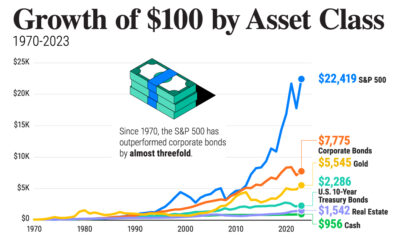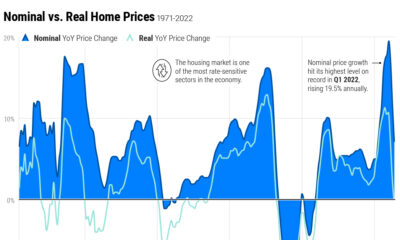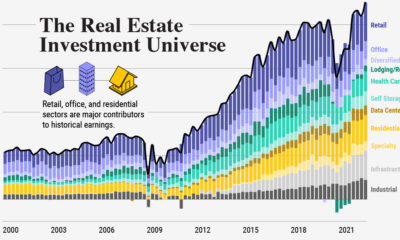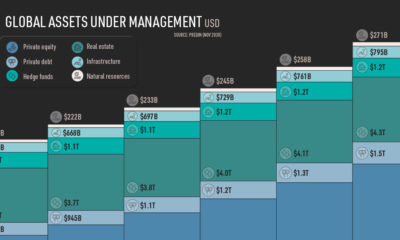This infographic is available as a poster.
The Growth in U.S. House Prices by State
On average, the U.S. housing market has seen price appreciation of 4.4% annually since 1991. High demand and low supply have accelerated price growth during the COVID-19 pandemic. In fact, single-family house prices grew by 18.7% from the first quarter of 2021 to the first quarter of 2022—the highest growth seen in at least 31 years.
This Markets in a Minute from New York Life Investments, the first in a three-part series on house prices, shows how house price growth has differed by state over various timeframes.
How Is House Price Growth Measured?
We used data from the Federal Housing Finance Agency’s (FHFA) House Price Index. The index measures changes in single-family home values and is seasonally adjusted. It is also a repeat-sales index, meaning it measures average price changes in repeat sales on the same properties.
FHFA obtains this information by reviewing repeat mortgage transactions on single-family properties whose mortgages have been purchased or securitized by Fannie Mae or Freddie Mac.
Short and Long-Term Growth in House Prices
The below table shows house price growth over the last year, last five years, and since the first quarter of 1991. It should be noted that the growth measures up to March 2022, based on the latest available data. As of March 2022, higher mortgage rates had not yet translated into slower price growth.
| State/District | 1-Year Rank | 1-Year Growth
| 5-Year Growth
| Growth Since Q1 1991 |
| Florida | 1 | 29.8% | 81.5% | 389.1% |
| Arizona | 2 | 27.5% | 91.4% | 433.6% |
| Utah | 3 | 26.8% | 99.6% | 599.2% |
| Tennessee | 4 | 25.8% | 79.7% | 316.6% |
| Idaho | 5 | 25.5% | 121.6% | 509.2% |
| Montana | 6 | 25.2% | 77.1% | 532.5% |
| Nevada | 7 | 25.0% | 83.1% | 293.8% |
| North Carolina | 8 | 23.4% | 72.8% | 268.4% |
| Hawaii | 9 | 22.8% | 59.2% | 257.8% |
| South Carolina | 10 | 22.7% | 67.0% | 263.0% |
| Georgia | 11 | 22.1% | 70.7% | 261.2% |
| Maine | 12 | 22.0% | 71.5% | 287.5% |
| Washington | 13 | 21.8% | 83.1% | 466.4% |
| Colorado | 14 | 21.6% | 70.6% | 578.6% |
| New Hampshire | 15 | 21.2% | 66.7% | 285.3% |
| California | 16 | 20.0% | 63.1% | 310.8% |
| Texas | 17 | 19.8% | 58.7% | 310.6% |
| Alabama | 18 | 19.7% | 58.6% | 218.5% |
| Arkansas | 19 | 19.2% | 51.2% | 207.5% |
| South Dakota | 20 | 18.3% | 56.7% | 326.8% |
| Vermont | 21 | 18.1% | 50.8% | 238.9% |
| Oregon | 22 | 18.0% | 63.1% | 514.3% |
| Oklahoma | 23 | 17.6% | 47.3% | 232.1% |
| Wyoming | 24 | 16.9% | 47.2% | 371.4% |
| Kentucky | 25 | 16.8% | 52.2% | 232.7% |
| Mississippi | 26 | 16.7% | 41.6% | 176.9% |
| Rhode Island | 27 | 16.7% | 61.2% | 236.1% |
| Missouri | 28 | 16.5% | 57.3% | 236.1% |
| Kansas | 29 | 16.3% | 52.6% | 239.3% |
| Michigan | 30 | 16.1% | 59.5% | 220.8% |
| Indiana | 31 | 15.7% | 61.0% | 200.9% |
| Ohio | 32 | 15.3% | 57.8% | 186.0% |
| Wisconsin | 33 | 15.2% | 55.1% | 261.8% |
| Virginia | 34 | 15.1% | 49.9% | 253.8% |
| New Jersey | 35 | 15.1% | 50.8% | 231.0% |
| New Mexico | 36 | 15.0% | 52.1% | 242.8% |
| West Virginia | 37 | 14.8% | 38.3% | 181.7% |
| Massachusetts | 38 | 14.8% | 54.8% | 300.1% |
| Nebraska | 39 | 14.6% | 53.8% | 264.9% |
| Pennsylvania | 40 | 14.5% | 49.4% | 208.6% |
| New York | 41 | 14.4% | 50.3% | 233.1% |
| Connecticut | 42 | 13.5% | 43.9% | 137.1% |
| Maryland | 43 | 13.1% | 40.6% | 229.0% |
| Delaware | 44 | 13.0% | 47.6% | 182.7% |
| Illinois | 45 | 13.0% | 35.3% | 159.0% |
| Minnesota | 46 | 12.7% | 48.5% | 284.8% |
| Iowa | 47 | 12.5% | 38.1% | 215.5% |
| Louisiana | 48 | 12.3% | 31.5% | 248.1% |
| Alaska | 49 | 10.5% | 29.1% | 222.4% |
| North Dakota | 50 | 10.4% | 26.2% | 280.6% |
| D.C. | 51 | 6.6% | 34.8% | 555.6% |
Over the last year, the growth in prices was highest in Florida. Close to a thousand people move to Florida every day, and some snowbirds have decided to make Florida their permanent home.
Arizona follows closely behind, with one-year house price growth reaching 27.5%. Houses are not being built fast enough to meet demand. While Phoenix and the surrounding areas have plenty of single-family homes, there is little high-density housing due to zoning restrictions.
If we take a longer view, house prices have grown the fastest in the West since 1991. Utah saw the highest growth of 599.2%. The state’s population has gotten three times larger over the last 50 years, due to both migration and a high fertility rate. Some are drawn by high tech opportunities that earned the state the nickname “Silicon Slopes”.
Of course, the above data has limitations in that it is across entire states. The FHFA also shares the metro areas with the highest house price growth over the last year. In line with state growth, the top four areas are all in Florida. However, number five on the list is Knoxville, Tennessee. The price growth is partly due to a supply shortage. Knox County had 1,332 active listings in 2019, and just 324 listings by the end of 2021.
The Factors Driving the Growth in House Prices
While home price growth has accelerated during the COVID-19 pandemic, the supply-demand imbalance has been building over time.
The U.S. built 276,000 fewer homes annually between 2000-2020 compared to the 30 years prior. Zoning restrictions in some areas have also limited the number of housing units that can be built on a parcel of land. Since the 2008 global financial crisis, roughly 64% of all authorized housing has been single-family homes. Ultimately, the lack of housing has helped drive up prices.
The magnitude of the price gain depends on where a homeowner had purchased. Historically, the growth in real estate prices has been highest in areas with strong job prospects, high population growth, and low housing supply.
In the second part of the house price series, we’ll explore the relationship between house prices and inflation.



 Infographics2 years ago
Infographics2 years ago
 Markets in a Minute2 years ago
Markets in a Minute2 years ago
 Infographics2 years ago
Infographics2 years ago
 Markets in a Minute1 year ago
Markets in a Minute1 year ago
 Markets in a Minute2 years ago
Markets in a Minute2 years ago
 Infographics1 year ago
Infographics1 year ago
 Markets in a Minute2 years ago
Markets in a Minute2 years ago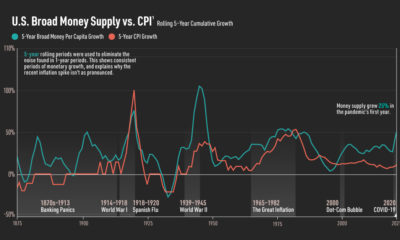
 Markets in a Minute2 years ago
Markets in a Minute2 years ago







